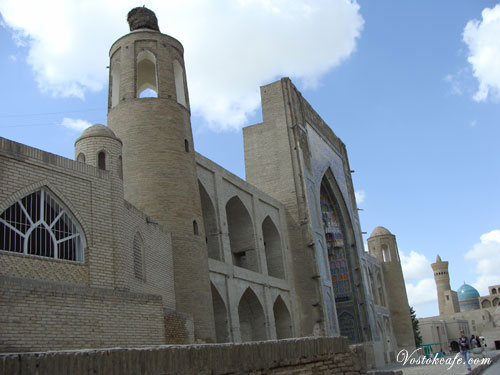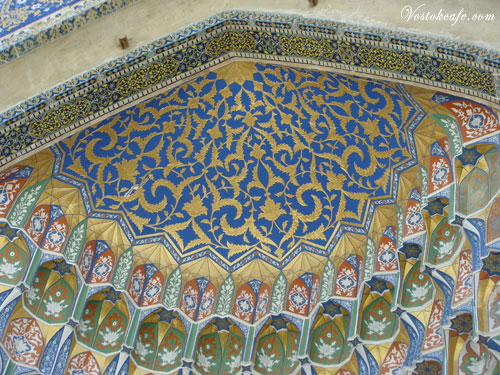|
Category
|
Abdulaziz Khan Madrassah
According to legend, Abdulaziz Khan from Ashtarkhanids dynasty (1645-1680) was a student ("murid") of Khalifa Hudoydod consisting of both a murid of another Ishan (spiritual mentor) - Mavlono Sharif (XVII c.) Both ishan long fought for influence in the Khan, who hesitated, who are preferred. This explains the location of the Madrasah Abdulaziz Khan, which, though true to the historic quarter Azizon, but still built on the border district Mavlono Sharif in the north. Tomb of Mavlono Sharif - the main shrine of the quarter - was inside the mausoleum, built nearby, next to the mosque. The mausoleum is preserved. Abdulaziz Khan had serious health problems. With age, his body was almost paralyzed. This explains the fact that Khan so much in need of supernatural protection.
The choice of decoration reflects the tendency of relieving the pressure from the religious taboos of orthodox Islam. This Abdulaziz-khan Madrassah follows its famous predecessors such as the Sherdor Madrasah in Samarkand and madrassah of Nadir Divan-Begi in Bukhara. Instead of modest geometric ornament is used more complex items such as the mythical Chinese dragon image and the birds Semurg (a fantastic "Bird of happiness" in Zoroastrian mythology). |
 Abdulaziz-khan Madrassah, built in 1652, erected on a single axis of Ulugbek Madrassah and is with him a single architectural ensemble, but far exceeds it, and the extent and richness of the decor. Abdulaziz-khan Madrassah has a special place among the monuments of Bukhara in the richness of artistic decoration. Diffusers covers painted in the technique of "kundal" (multicolour painted with gold embossed on the ornament). The external decoration predominates with a characteristic mosaic motif of flowering shrub in the vase. The interior of the cupola of stalactites and complex sails, as well as the art of painting. In the design of the courtyard and rooms used by a wide range of decorative techniques, typical of that time including: Curtain coating and carved ceramics, brick mosaic, carved marble, ganch frescoes and gilding. Madrasah includes four aivans yard with portal entrance, corner towers - "guldasta" and lodge-niches around the yard and on the facade.
Abdulaziz-khan Madrassah, built in 1652, erected on a single axis of Ulugbek Madrassah and is with him a single architectural ensemble, but far exceeds it, and the extent and richness of the decor. Abdulaziz-khan Madrassah has a special place among the monuments of Bukhara in the richness of artistic decoration. Diffusers covers painted in the technique of "kundal" (multicolour painted with gold embossed on the ornament). The external decoration predominates with a characteristic mosaic motif of flowering shrub in the vase. The interior of the cupola of stalactites and complex sails, as well as the art of painting. In the design of the courtyard and rooms used by a wide range of decorative techniques, typical of that time including: Curtain coating and carved ceramics, brick mosaic, carved marble, ganch frescoes and gilding. Madrasah includes four aivans yard with portal entrance, corner towers - "guldasta" and lodge-niches around the yard and on the facade. Abdulaziz-khan Madrassah was the last monumental building of this scale in the capital of the Bukhara Khanate. After the death of Abdulaziz Khan followed a period of decline of Bukhara. Never over Bukhara was not rich enough and stable to carry out construction of luxury buildings as Abdulaziz-khan Madrassah.
Abdulaziz-khan Madrassah was the last monumental building of this scale in the capital of the Bukhara Khanate. After the death of Abdulaziz Khan followed a period of decline of Bukhara. Never over Bukhara was not rich enough and stable to carry out construction of luxury buildings as Abdulaziz-khan Madrassah.














